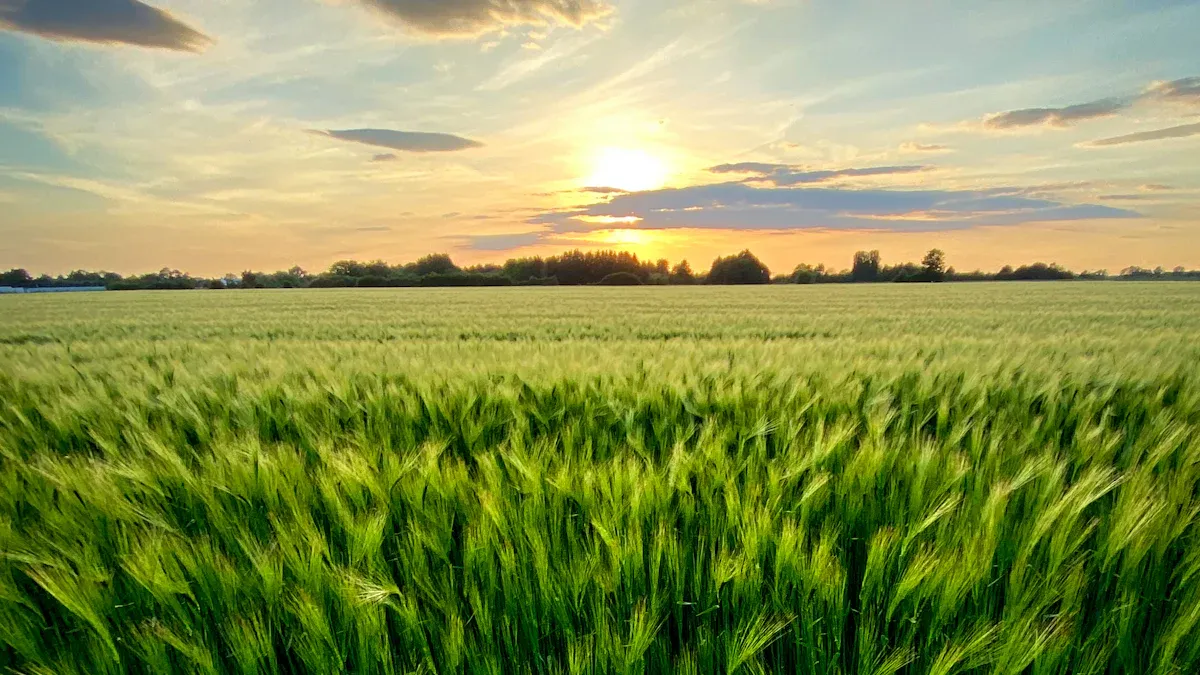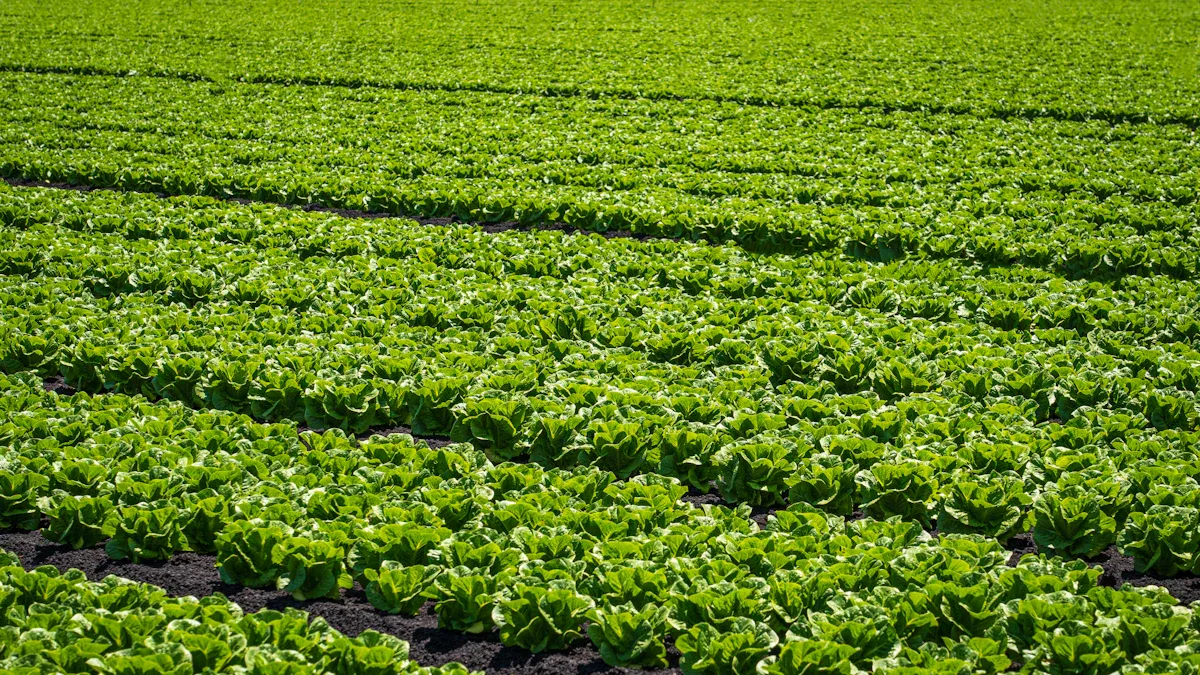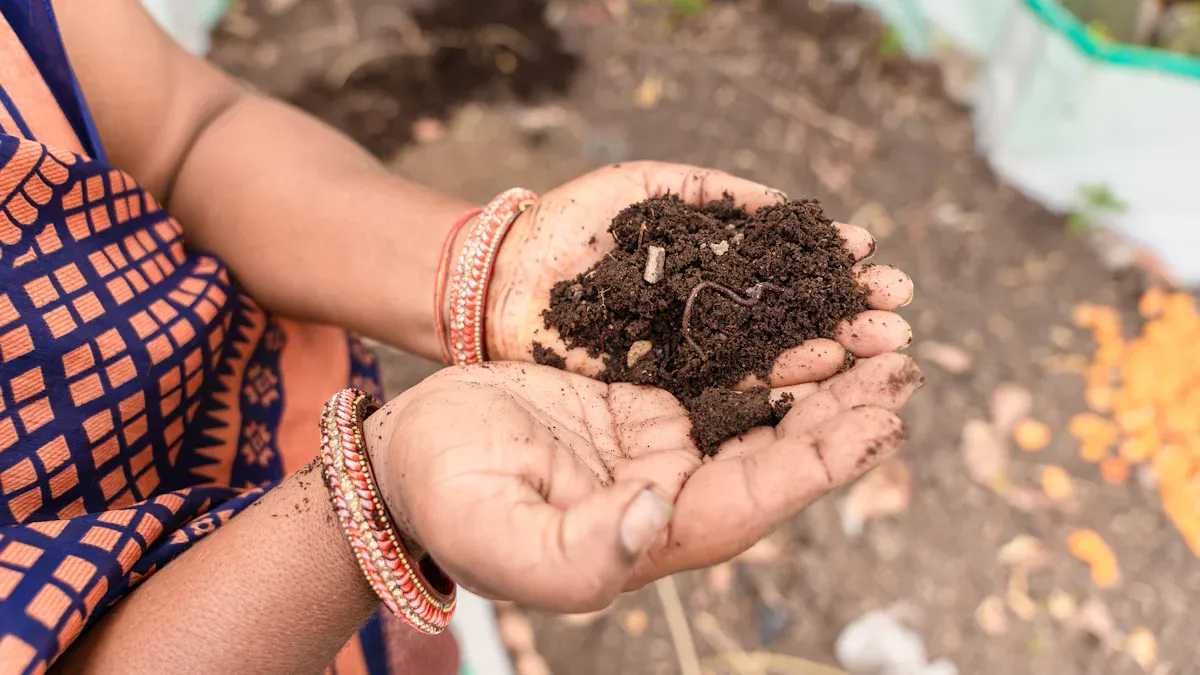Mineral Potassium Humate Fertilizer: The Smart Choice for Thriving Crops

Mineral potassium humate fertilizer helps plants grow better. It makes soil stronger and helps plants take in more nutrients. It also helps plants handle stress. Farmers see roots grow 30% bigger. Soil holds 20-30% more water, so crops get stronger and healthier. Potassium humate helps plants by making cation exchange capacity better. It also helps more good microbes live in the soil. This makes it good for all farm crops. This fertilizer means farmers use fewer synthetic products. It saves money and can make crops grow 25% more. A good mineral potassium humate fertilizer supplier keeps soil healthy. It helps plants grow well and crops do great every season.
Key Takeaways
Potassium humate fertilizer helps soil keep more water and nutrients. This makes roots stronger and plants healthier.
Using potassium humate helps good microbes grow in the soil. These microbes make it easier for plants to get nutrients. They also help protect crops from stress and disease.
Using potassium humate at the right time and amount helps crops grow bigger. It also helps crops give more food. This can help farmers spend less money on chemical fertilizers.
Potassium humate works best when mixed with other fertilizers. It should be put on soil that has enough water. This helps plants take in more nutrients and keeps soil healthy.
Picking a trusted supplier with good potassium humate is important. This gives farmers pure and strong fertilizer. It helps crops grow well every season.
What Is Potassium Humate?
Composition
Potassium humate comes from leonardite. Leonardite is made from old plant material. This organic potassium fertilizer has humic acids. Humic acids are important for soil health. Scientists say potassium humate is large and has many active parts. These parts help it work well as a fertilizer. It raises the amount of potassium in soil. Plants can take in potassium more easily.
Potassium humate fertilizer also has minerals like calcium and magnesium. These minerals help change soil chemistry. They also help good bacteria grow in the soil. The fertilizer comes as powder, liquid, or granules. Farmers pick the type that fits their crops and soil.
Note: Potassium humate works best in soil with pH from 6.0 to 7.5. In this range, plants can take in iron, magnesium, and calcium better.
How It Works
Potassium humate helps soil and plants in many ways. It adds organic matter by helping microbes break down old plants. This makes humus, which improves soil and helps it hold water. The fertilizer acts as a chelating agent. This means it keeps nutrients from washing away. Plants can use these nutrients when they need them.
Potassium humate helps roots grow by making root cells divide and get longer.
It increases good microbe activity in soil. This helps recycle nutrients and keeps soil healthy.
The fertilizer helps soil stick together in small groups. This stops erosion and keeps soil good for a long time.
The table below shows how potassium humate helps plants get nutrients, even when stressed:
Mechanism Aspect | What Happens in the Plant | Why It Matters for Nutrient Uptake |
|---|---|---|
Ion Homeostasis | More potassium and less sodium in roots | Nutrients stay balanced and salt stress is lower |
Na+/K+ Ratio | The ratio stays steady, even when stressed | Plants do not get hurt by too much sodium |
Calcium Accumulation | Roots get more calcium | Roots get stronger and nutrients move better |
Starch and Sugar Changes | Plants use energy better during stress | Roots and shoots keep growing |
Microbial Activity | More good microbes live in the soil | Nutrients move faster and reach plant roots |
Using potassium humate fertilizer for a long time makes soil healthier. It helps soil keep more water and gives bigger crop yields. Farmers see plants that are stronger and can fight drought and disease. This makes potassium humate a smart choice for people who want better soil and plants.
Potassium Humate Fertilizer Benefits

Soil Structure
Potassium humate helps soil in many ways. It makes soil particles stick together. This forms small groups called aggregates. These groups make more space for air and water. Roots can breathe and grow deeper. Potassium humate makes soil less hard. Roots move through the soil more easily. Farmers see softer and crumbly soil after using it. This helps roots grow better and plants get stronger. Good soil stops erosion and keeps nutrients in place. Loose soil lets water move and reach roots faster. Over time, potassium humate makes soil healthier and more fertile.
Water Retention
Potassium humate helps soil hold more water. It acts like a sponge and keeps water longer. Studies show it can hold 20-30% more water in rich soils. Crops with potassium humate survive dry times better. The soil keeps more moisture for the plants. Farmers do not need to water as often. This saves water and time. Potassium humate also lowers soil salt, so roots take in water easier. Humic substances help soil and microbes, which keeps more water in the soil. Farmers see stronger crops during dry seasons. Potassium humate supports healthy soil.
Potassium humate helps soil hold 20-30% more water.
Crops can live through dry times with more moisture.
Better soil and microbes help keep water in the soil.
Farmers water less often when using potassium humate.
Humic substances lower salt and help roots get water.
Using the right amount helps with salt and water in soil.
Potassium humate makes soil better and crops stronger.
Microbial Activity
Potassium humate helps good microbes grow in soil. It gives food to bacteria and fungi. It has sugars, acids, and amino acids for microbes. When added to soil, it makes more kinds of microbes grow. Farmers see more soil enzymes, which means healthy microbes. Potassium humate brings back good microbes after soil treatments. It helps Bacillus, Firmicutes, and other good microbes grow. It also stops bad germs like Fusarium and Phytophthora. This makes plants healthier and soil better. Nutrients move better, plants grow stronger, and crops are bigger.
Humic acid fertilizers add more organic matter and nutrients.
Potassium humate helps more good microbes grow in soil.
It makes soil enzymes work better, showing healthy microbes.
The fertilizer raises ammonium nitrogen and lowers nitrate nitrogen.
Potassium humate stops bad germs and helps good microbes.
These changes help crops make more fruit.
Note: Potassium humate works best with other organic fertilizers. This mix helps plants get more nutrients and keeps soil healthy.
Nutrient Uptake
Potassium humate helps plants take in more nutrients. It makes soil hold more nutrients for plants. Plants get more nitrogen, phosphorus, and potassium. Seeds sprout better and roots grow faster. This helps plants take in more food. Potassium humate keeps soil pH between 6.0 and 7.5. This keeps nutrients ready for plants to use. Farmers see more crops and healthier plants. Potassium humate adds more organic matter to soil. This helps soil keep nutrients and stay fertile. More good microbes help move nutrients to plants. Over time, soil gets better and plants get what they need.
Plants take in more nitrogen, phosphorus, and potassium.
Seeds sprout better and roots grow faster.
More good microbes help move nutrients to plants.
Soil holds 10-50 mmol/kg more nutrients.
Soil pH stays in the best range for plants.
Soil gets 1-5% more organic matter and holds more nutrients.
Farmers see more crops and healthier plants.
Tip: Use potassium humate often to keep nutrients in the soil. This helps plants grow well all season.
Crop Growth and Yield

Root Development
Potassium humate biostimulant helps roots grow bigger and stronger. When farmers use potassium humate fertilizer, roots get larger. Studies show spraying 150 g/L makes roots longer and heavier. Bigger roots help plants take in more water and nutrients. Potassium humate helps cell walls let in more water. It also makes hormones like auxin and cytokinin work better. These hormones help roots grow and cells split. The soil gets more good microbes, which helps roots stay healthy. Strong roots let plants reach water and food deep in the soil. This helps plants grow better and gives more crops.
Stress Resistance
Potassium humate biostimulant helps crops deal with drought, salt, and disease. It makes soil better and adds more organic matter. This lets soil keep more water near the roots. Plants lose less water when it is dry because potassium humate helps close tiny leaf holes. Water loss drops by over half during drought. The fertilizer makes plant cell walls stronger and helps plants fight disease. Disease goes down by up to 70% in treated crops. More good microbes grow, which helps plants fight bad germs. These changes make crops tougher and healthier.
Quality and Safety
Potassium humate fertilizer makes crops better and safer to eat. Plants with potassium humate have more balanced nutrients and less nitrate. This makes fruits and vegetables taste sweeter and safer for people. The fertilizer keeps soil pH steady and adds more organic matter. Crops grown with potassium humate have fewer bad leftovers. Better nutrient use and root growth give crops better color, size, and shelf life. Farmers get higher quality food, which is good for buyers and sellers.
Higher Yield
Potassium humate fertilizer helps many crops make more food. Tests show cotton, potato, soybean, and tomato give more when using potassium humate. For example, potato seeds sprout more, from 15% to 70%. Soybean crops give more with just 5 kg per hectare. The table below shows how much more crops farmers get:
Crop | Application Rate | Yield Improvement / Effects |
|---|---|---|
Cotton | 10-20 L ha−1 | More seeds sprout, better growth, higher yield, better fiber |
Potato | Not specified | Up to 70% sprouting, more potatoes |
Soybean | 5 kg ha−1 | More nodules, more pods, higher yield |
Tomato | Not specified | More tomatoes, more plant mass, better harvest |
Potassium humate biostimulant helps plants grow, take in potassium, and make more crops. Farmers see bigger harvests and more food every season.
Using Potassium Humate Fertilizer
Application Methods
Farmers use potassium humate in different ways. The most popular way is putting it in the soil. This helps roots grow and plants take in more nutrients. It also makes the soil better. When farmers add enough water, plants get stronger and soil keeps more water. Another way is spraying it on leaves. This helps plants during dry weather but does not help roots as much. Farmers can also use irrigation systems to spread it. This works well for big fields and spreads the fertilizer evenly.
Application Method | Best Use | Main Benefits |
|---|---|---|
Soil application | With good irrigation | Strongest root growth, better nutrient uptake, improved soil structure |
Foliar application | During water stress | Some help with water status, minor soil pH change |
Irrigation system | Large fields | Even fertilizer spread, supports soil and plant health |
Tip: Putting potassium humate in the soil with enough water works best for most crops.
Rates and Timing
Using the right amount and at the right time is important. Tests show that 2.5 kg per hectare can make grain yield go up by almost 28%. Farmers often use potassium humate with nitrogen fertilizer for better results. It works well to use it at the start of the season and again when plants have about 8 or 9 leaves. This matches important growth times and helps plants use food better. Farmers should always read the label for their crop and soil.
Parameter | Recommended Rate/Timing | Effect |
|---|---|---|
Potassium humate application rate | 2.5 kg/ha | Higher yield, better nutrient use |
Application timing | Basal and 8.5 leaf stage | Supports growth and nutrient uptake |
Combined with nitrogen fertilizer | 100-400 kg N/ha | Boosts yield and protein content |
Compatibility
Potassium humate mixes well with many fertilizers. Farmers often mix it with nitrogen, phosphorus, or NPK blends. This helps plants get more nutrients and use them better. Potassium humate also helps plants take in micronutrients. It stops nutrients from washing away and keeps soil healthy. Farmers can use it with most crop protection products. Always check the label before mixing.
Works with nitrogen, phosphorus, and NPK fertilizers
Helps plants take in micronutrients
Stops nutrients from washing away and keeps soil healthy
Good for sustainable farming
Note: Mixing potassium humate with other fertilizers can make crops stronger and soil better.
Choosing a Mineral Potassium Humate Fertilizer Supplier
What to Look For
Picking the right mineral potassium humate fertilizer supplier helps farmers grow better crops. A good supplier uses natural things like leonardite. This gives better humic substances. The best suppliers use cold-water extraction. This keeps the fertilizer clean and full of nutrients. Farmers should check if the product is pure and has enough nutrients. More humic acid means plants can take in more nutrients. Potassium amount and how well it dissolves in water are important too. A trusted mineral potassium humate fertilizer supplier will give certificates of analysis. These papers show how much humic acid and potassium are in the fertilizer.
Farmers can use this checklist when picking a supplier:
Where the humic substances come from (leonardite is best)
How it is made (cold-water extraction is best)
Humic acid amount (should be at least 55% dry)
Potassium amount (K2O should be 8-12%)
How well it dissolves in water (99% is best)
pH range (should be 9-10 for farming)
Certificates of analysis should be given
Farmers should ask the mineral potassium humate fertilizer supplier about these things before buying.
Quality Assurance
A trusted mineral potassium humate fertilizer supplier shows proof of quality. Third-party checks, like SGS or BV, make sure the product is safe and pure. Suppliers should give certificates that match what is on the label. Some suppliers even give money back if the purity is lower than promised. Farmers should look for products with organic certificates or other quality marks. These steps help make sure the fertilizer is safe and works well for crops.
The table below shows important quality signs:
Quality Indicator | Preferred Value or Certification |
|---|---|
Humic Acid Content | Minimum 55% (dry basis) |
Potassium Content (K2O) | 8-12% |
Water Solubility | 99% |
pH Range | 9-10 |
Third-Party Inspection | SGS, BV |
Certificate of Analysis | Must be available |
Money-Back Guarantee | If purity is below certificate values |
Farmers who pick a mineral potassium humate fertilizer supplier with these standards can trust the product to help their crops grow well.
Potassium humate fertilizer is a good pick for today’s farms. Research shows it makes soil better and helps it hold more water, up to 30% more. It also helps more good microbes live in the soil. Farmers notice roots get stronger and plants use more nutrients. Crops grow bigger and give more food. Potassium humate lets farmers use fewer chemicals and keeps soil healthy. People who want strong crops and to save money over time should use potassium humate in their fields.
FAQ
What crops benefit most from potassium humate fertilizer?
Many crops grow better with potassium humate. Farmers use it for grains, vegetables, and fruits. It also helps turf grass. Potatoes, soybeans, and tomatoes do very well. This fertilizer works for field crops and greenhouse crops.
How often should farmers apply potassium humate?
Farmers put potassium humate on at planting time. They use it again when plants are growing fast. Two or three times each season is best. Always read the label for the right time to use it.
Can potassium humate replace chemical fertilizers?
Potassium humate cannot take the place of all chemical fertilizers. It works best when used with other fertilizers. Farmers can use less synthetic fertilizer with potassium humate. This helps save money and keeps soil healthy.
Is potassium humate safe for organic farming?
Potassium humate made from natural leonardite is good for organic farms. Farmers should look for organic certification on the label. Certified potassium humate helps organic crops grow well.
See Also
How Potassium Humate Fertilizer Enhances Plant Development
Comparing Potassium Fulvate And Humate: Differences And Applications
Sodium Humate’s Impact On Modern Farming And Industrial Progress
